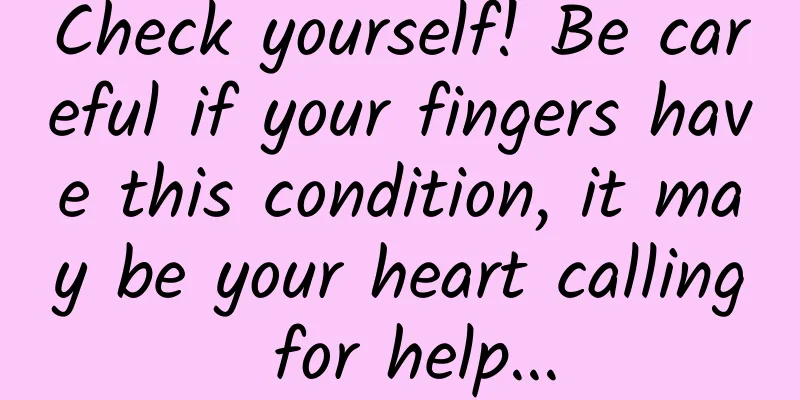Check yourself! Be careful if your fingers have this condition, it may be your heart calling for help...

|
Reviewer of this article: Yang Shi, Associate Researcher, Center for Comparative Medicine, Peking Union Medical College People often use the phrase "the heart is connected to the fingers" to describe the close relationship between the fingers and the heart. Whether the heart is healthy can sometimes be seen from the fingers. Some abnormal finger manifestations may be a warning of heart disease. Fingers tremble and the ends swell It may be a "warning" from the heart Professor Zheng Junmeng, director of the Department of Cardiovascular Surgery at Sun Yat-sen Memorial Hospital of Sun Yat-sen University, introduced that when heart disease occurs, some unusual symptoms will appear in the fingers, including: finger tremors, nail abnormalities and clubbing. Finger tremors The heart is the lifeblood of the human body. If the heart stops beating, the person is also heading towards the end of life. If the heart is weak, the fingers will often tremble and not obey commands, especially when holding things. Some people with very serious heart diseases have almost constant trembling of their fingers. Nail abnormalities Some people's fingers are obviously different from others. Generally speaking, the nails on normal fingers are round and full, while the nails of patients with heart disease are uneven. The condition of the half-moons on the fingers of normal people generally remains unchanged. The half-moons can reflect a person's physical health status, but it does not mean that the more half-moons the better. Instead, if the number or shape of the half-moons changes over a period of time, it means that there are certain changes in themselves. Finger clubbing Finger clubbing refers to a deformity in which the ends of fingers or toes grow, hypertrophy, widen, and thicken, and the distal phalanx is arched and enlarged from the base to the end, forming a club-like swelling. The symptom usually occurs symmetrically on both hands and feet. The angle formed by the nail when it extends from the fingertip is called the suprasegual angle. In normal people, the suprasegual angle is ≤160°. In clubbing, this angle is ≥180°, and the soft tissue of the terminal phalanx is spherical, shaped like a drumstick. Professor Zheng Junmeng introduced that there is a relatively simple self-test method for clubbing - the Schamroth sign test method, which is to stick the nail surface and the back of the knuckle of the last segment of the same finger (usually the middle finger) of both hands together. Under normal circumstances, a diamond-shaped window is formed at the base of the two nails, and if this gap becomes smaller or disappears, it is clubbing. Doctor's reminder If you find any abnormality in your fingers, be sure to seek medical attention immediately Professor Zheng Junmeng reminds that if the above symptoms appear on the fingers, you may have these heart diseases, including: congenital heart disease (such as tetralogy of Fallot, trilogy of Fallot, transposition of the great vessels of the heart, etc.), infectious heart disease (subacute bacterial endocarditis, rheumatic heart disease, infectious myocarditis), and other cardiovascular diseases. In particular, cyanotic congenital heart diseases such as tetralogy of Fallot, Eisenmenger syndrome, and transposition of the great vessels are usually accompanied by cyanosis and clubbing, and the severity of clubbing is often parallel to the severity of cyanosis and the duration of the disease. However, newborns and patients with severe anemia are exceptions. The former only have cyanosis without clubbing, while the latter have obvious clubbing but mild cyanosis. "Once you find abnormalities in your fingers, you must go to the hospital as soon as possible to avoid delaying treatment." Professor Zheng Junmeng said that the doctor will conduct further examinations on the patient, such as physical examination, blood routine, blood gas analysis, electrocardiogram, imaging examination, etc., to determine the cause of the disease and provide symptomatic treatment. In addition to heart problems, finger abnormalities may also indicate problems in these parts: ① Clubbing may indicate lung disease <br /> If you find yourself with clubbing, it may be a sign of cardiovascular disease or other diseases. Generally speaking, clubbing is mostly related to hypoxia. When the body is deprived of oxygen, the fingers and toes are farthest away from the body. Hypoxia will stimulate the proliferation of these soft tissues and fibrous tissues, so the tips of the fingers will swell. Among them, patients with chronic obstructive pulmonary disease, emphysema, tuberculosis, chronic lung abscess, interstitial pulmonary fibrosis, and some lung cancer patients may have clubbing. In addition, finger clubbing can also be seen in diseases such as inflammatory bowel disease, cirrhosis and gastrointestinal tumors. ②Hand numbness and tremors? There are many causes that need to be investigated As mentioned earlier, if the heart is weak, the fingers will often tremble and not obey commands. However, there are many reasons for numbness and tremor in the hands, and it cannot be generalized. For example, people are prone to hand tremors when they are nervous or tired, which is a normal phenomenon. However, if the hand tremors persist and even affect their normal life, it is a cause for concern. Hand tremors in young and middle-aged people are often essential tremors, which may indicate hyperthyroidism. If hand tremors occur when using chopsticks to pick up food or writing, a thyroid function test is recommended. Hand tremors in the elderly may indicate damage to the central nervous system and the risk of Parkinson's disease and Alzheimer's disease. Electrocardiogram, brain CT and other examinations are recommended. You should also be careful about numbness in your hands. If the numbness in your hands persists for a long time, and it gets better and worse, and the numbness spreads from your hands to your legs and back, you should pay attention to check whether you have cervical spondylosis or a herniated disc. Frequent numbness in the hands of middle-aged and elderly people in a short period of time may be a precursor to a stroke. It is recommended to seek medical attention in time and follow the doctor's advice to undergo brain CT scans, carotid artery ultrasound and other examinations. Source: Guangzhou Daily, Health Appointment The pictures in this article with the "Science Popularization China" watermark are all from the copyright gallery. The pictures are not authorized for reprinting. |
<<: Ten tips to prevent colds in winter
>>: The nagging anesthesiologist
Recommend
Why do you have to leave the fresh meat aside for a few days instead of eating it?
Review expert: Wang Guoyi, Postdoctoral Fellow in...
Can fingers be infected with HPV? Many girls like to do this, but you must be careful →
A while ago, there was a news report about a youn...
Google's secret to staying technologically competitive: global-scale engineering first
[[341436]] This article is based on my personal e...
Want to achieve the "complete form" of intelligent driving? Cars, roads, and clouds must first "align granularity"
With the mature development of new energy intelli...
Summary of optimization of information flow and fan delivery!
There are two types of information flow followers...
World Autism Day: Caring for “Children from the Stars”
They live among us But I have a heart that can on...
ATET A8 Bluetooth controller with customized appearance review
As one of the control standards for many games, t...
7000 words, predicting the new media operation trends in 2019
From 2016 to this year, it is the third year for ...
How much does it cost to develop a financial app in Xining?
More and more businesses are paying attention to ...
A good product for health preservation, a magic weapon for fighting cancer... Is the "magic medicine" Ganoderma lucidum spore powder reliable?
"After taking Ganoderma lucidum spore powder...
This little bug's "kiss" may have troubled Darwin throughout his life...
In 1835, the 26-year-old Darwin followed the wars...
New media operation: 8 minefields in title creation!
Recently, I often see friends in the background l...
Hundreds of millions of people are lactose intolerant, so why are we still recommending you to drink milk?
There is no need to say much about the benefits o...
Samsung S5 heart rate sensor test
Samsung has officially entered the health and fitn...









